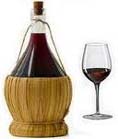Drinking Glasses
from Italian Traditional Food
About drinking glasses
Check out these great Italian ideas at Amazon for Italian food and kitchen ideas.
Short history of drinking glasses
Venice was the centre of European glass-making in the mid-15th
century, and it was not until after the Restoration that the first British glass was evolved by chemist George
Ravenscroft. Initially, this "flint glass" was subject to "crisselling", the appearance of a network of tiny
cracks, and a high proportion of lead oxide was added to prevent it. This lead is what gives English lead crystal
its characteristic thick, liquid, "oily" look.
Stronger than the delicate Venetian "cristallo"
Stronger and heavier than the delicate Venetian "cristallo", its
robust quality dictated the simpler shapes. Early glasses have V-shaped funnes and very short stems, in imitation
of the Venetian, and the feet were "welted" or down-folded in a double thickness for extra strength. If turned
upside down, a small, rough patch or "pontil" mark should be seen. This happened when the glass was transferred,
still in its plastic state, from the glass-blower's iron to a shorter rod or pontil for fashioning.
Drinking glasses of
the early 18th century were simple, influenced by contemporary silver; and bell and bucket bowls were much in
evidence. Stems grew longer in proportion to the size of the bowl and foot and the "baluster", a sphere tapering
at one end, combined with one or more balls or "knops", became the basis of many variations. In a practical way,
they prevented the longer-stemmed glasses from slipping through the fingers when drinking.
The accession of George I in 1714 brought the "Silesian" stem into
fashion. This tapers from flattish shoulders below the bowl and has a minimum of four flat cuts from top to base.
Bowls began to flare outwards in waisted curves and as stems lengthened still more in proportion, the straighter
ones carried "twists", bubbles of air drawn with the stem to form complicated webs of thin lines inside.
Tiny bowls on long, thick stems were used for cordials (liqueurs",
while "drams" or small, squat glasses were used for tossing down fiery spirits. Some of these, known as "firing"
glasses, were very thick at the foot and were rapped on the table at a gathering to signify applause. The sound was
like musket fire - hence the name.
Page 2 of this Italian Traditional Food
article on drinking glasses can be found on the next page.
Page 1 Next
>>

Copyright © 2009 -
. All Rights Reserved Worldwide. Italian Traditional Food
You may not reprint articles from this website
without the written permission of the site owner.
Disclaimer: Articles on this
Website are provided for information purposes only. Italiantraditionalfood.com does not accept any responsibility
or liability for the use or misuse of the article content on this site or reliance by any person on the site's
contents.
| 


 Digg
Digg Stumbleupon
Stumbleupon Google Bookmarks
Google Bookmarks Delicious
Delicious Twitter
Twitter Facebook
Facebook Yahoo My Web
Yahoo My Web Reddit
Reddit